Hokitika grew up with its back to the sea, as Paul explained to us, the all- powerful Tasman waves claimed so many lives in their sucking under tow that the younger generation, himself included were brought up under threat of real punishment if they went anywhere near that shore.
It’s the sheer scale of the massive breakers that would put me off, but to some that is their attractiveness which draws in the unwary. We watched as a young mother walked her toddler along the water’s edge not watching as the tumbling waters approached like a pack of marauding hounds.
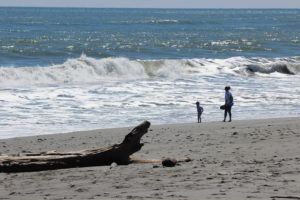
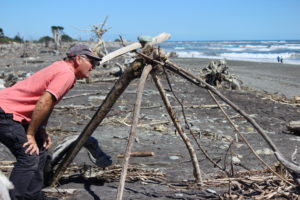
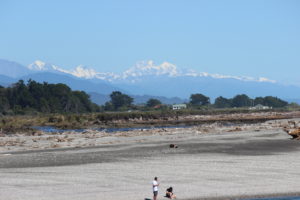
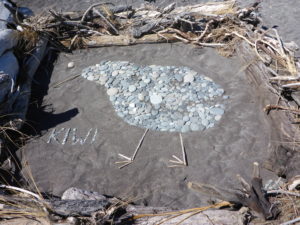
Jane and Paul owned a red roofed hotel along this seafront years ago and were the first to build an upstairs restaurant that dared to face the marine monster on their doorstep. They had sold up and launched their own steel yacht, Nora J, named after Jane, when we met them in Panama and they became line handlers for us before returning through the canal to collect Nora J.
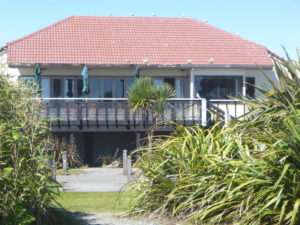
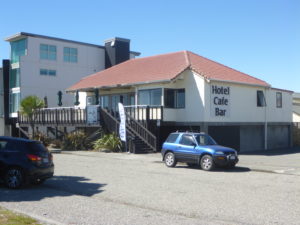
The innovative design of their home meant Rob and I stayed in the self-contained apartment beneath their self-contained one on top. We got together in the two evenings we were there to share a meal and chat. They have now completed their 20 year circumnavigation and are going through the difficult transition back to living in a beautiful but non-moving house. When I asked Jane if they had a party or celebrated the completion of their maritime marathon in any way she quietly replied, “Wish I was ten years younger”. The views from their dining room towards Mt Cook and the Tasman Sea were engrossing.

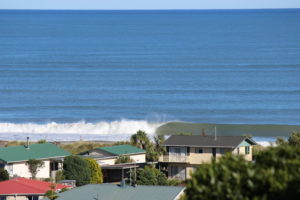
The sky was a clear blue backdrop to snow-capped Mt Cook and the Southern Alps as we drove over fertile farmland known as ‘flats’, towards Hokitika Gorge. A billy goat was tethered on one side of the road on a line just long enough for us to have to move right a little to avoid his bum. He gazed longingly across the road at the high fenced pen full with elegant females posing and teasing him.
Blue green mountain water ran through the gorge, turning a right angle bend infront of the rocks we were sitting on. To our left was the pedestrian suspension bridge we had crossed to get to our spot. A young lad stripped to his speedos and marched purposefully onto the bridge. Without any ado he climbed onto the rickety handrail, yelled and let go, his cross shaped body taking a good second over the long drop and making an alarming slap as it disappeared. We all watched with baited breath, then he surfaced and whooped an exclamation as he returned to the shore.
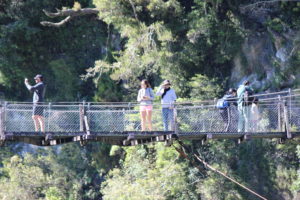
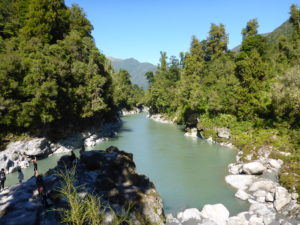
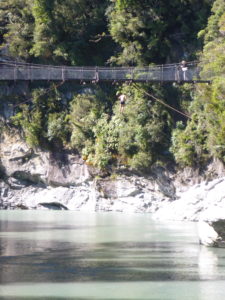
Taongas (treasures) of Hokitika.
Down in interesting Hokitika we window shopped in two Westland Greenstone (Pounamu or Jade) outlets where we watched the skilled craftsmen and women sawing and turning the stone into glistening amulets and ornaments. I bought a pendant in the shape of a Maori fish hook, Hei Matau which wishes the wearer health and prosperity. It also represents strength and determination (!), but most importantly it promises a SAFE PASSAGE OVER WATER. Best keep it on then.
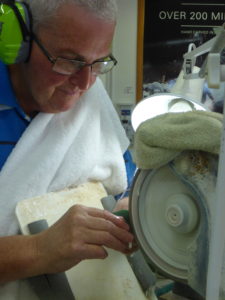
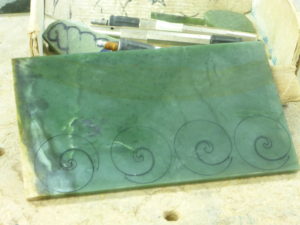
Many of the same men were involved in the gold rushes of California, Victoria Australia and New Zealand, travelling from place to place on the square riggers that once filled Westland’s Harbours. Hokitika’s gold rush was comparable to the California Rush of 1849 and the Klondike in 1900.
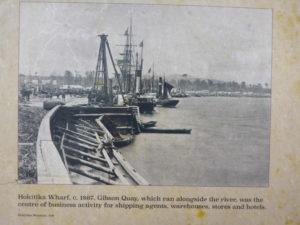
The gold here is 94% to 98% pure and the largest nugget ever found in NZ, weighing 3.09kg or 99.35oz was recovered just south of Hokitika. The kind lady at the counter in the Gold Room outlet shop let us hold in the palm of our hands a warm, glowing nugget found locally which was about the same size as our gold specked quartz rock. Well we can wish can’t we?
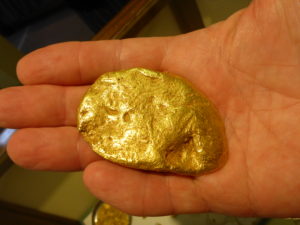
Just over the road another craft shop brought us back to earth, the Sock Factory. With a big collection of ageing sock knitting machines of all shapes and sizes on high shelves all around the shop and through a glazed screen we could have watched modern production but the lady owner was short staffed and had to man the till instead. “With so much possum used in clothing in NZ do you farm possums here?” I asked naively.
“No, there’s 18 million of the buggers out there, we just shoot ‘em between the eyes and strip ‘em while they’re still warm.”
All that closeness to things of high value had made us thirsty so we sat facing outwards in the Gold Room Café overlooking the main roundabout in Hokitika upon which stands the characteristic clock tower. We weren’t watching the time though; road workers were re-surfacing the road around the round-about and that provided excellent entertainment as we supped our flat whites. Pungent and glistening hot tar was poured from a nozzle controlled by a workman poised on the back of the lorry. The shape of the roundabout was presenting a little problem for the young driver who got the angle slightly wrong and backed over the rapidly cooling tar he had just laid. Net result, his back tyres became clothed in a sheet of blubbery black tar so when he drove forward it looked like a flap of skin slapping on the rubber.
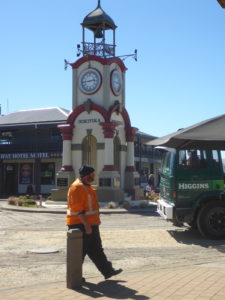
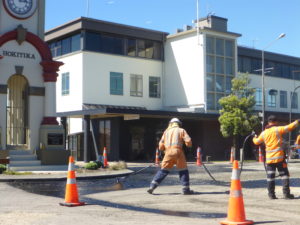
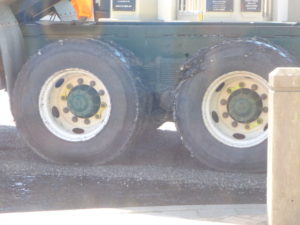
Before we returned to Paul and Jane’s home we booked our return crossing of the Cook Strait from Picton to Wellington for five days ahead and how fortuitous an arrangement did that prove to be.
We couldn’t leave the next morning without at least guessing at a reunion with Jane and Paul, too harsh a cut off that would have been. So we ‘planned’ to meet again either here in Hoky or at Havelock on the Cook Strait coast where Nora J is now moored. Internal flights in NZ are so cheap we could easily fly from Auckland to either of the ‘H’s.
Yet again we were transiting the South Island from Greymouth. The first time was via Arthurs Pass to Christchurch and now we were heading for Blenheim, which would have been almost due south from Picton down the east coast had that Highway not been wrecked by the last earthquake in November 2016.
We had to wait at the start of one sturdy bridge across a river. As we waited for oncoming cars we noticed a railway line across the same surface on this bridge. How amazing that would have been, to have to wait for a train to clear the bridge first.
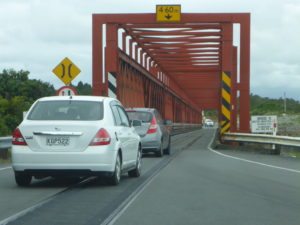
We were now in autumn and the fields were noticeably greener than when we came, as we moved north. Piles of black coal dust, rusting rolling stock and a big cemetery at Reefton combined to tell the story of past industry, road and railway building and its human cost.
We had a brief break at Lyell. Jane had mentioned it as an interesting old gold mining ghost town and we would have loved to have walked the 45 minute walk to the old town but the moment we emerged from Vicky the sand flies descended on any uncovered skin, so I took a few photos of the history boards for future reference and we moved on.
Around us there was evidence of mountain sides recovering from pine growth and de-forestation. The soil can nourish only two crops of pine trees before it is depleted of nutrients.
We were back on Highway 6 and many of the two way bridges we had seen under construction on our way down were finished, on this alternative route to the closed east coast highway. Some lorry drivers in their haste to minimise journey times on this longer route are using excessive speed which has so far cost five lives in accidents.
Now on Highway 63 to our left we had the Richmond Range of mountains extending along the far shore of the Wairau River and ahead were the vineyards of Marlborough. Green corduroy fields of vines reached to the far mountains. Kintyre Vineyards, Sauvignon Blanc, Olives and Clouds!
Tomorrow we would drink wine.
All Hail Bacchus
We had two days to spend in the area and the weather promised sun for the first and rain for the second day which would be our ‘museum day’. At the I-Site we found a wealth of information on wine tours by car, coach, and even bike to countless vineyards and were somewhat overwhelmed with choice. So we asked the passionate and knowledgeable lady what she would do on our wheels. “I’d spend the morning at Yealands Seaview Vineyard and have lunch at Brancott Estate.”
Two interesting facts she mentioned were the, famous in UK supermarkets, ‘Oyster Bay’ vineyard has no cellar door, wonder what they are hiding. I have just been reading the book about Peter Yealands which includes his attempted take-over of Oyster Bay Wines and it appears they had a lot to hide! Secondly there are no tours anywhere near fermenting vats of wine because in the last earthquake some fell over and spilled their wine. Tragic.
We sped down State Highway 1 over the Dashwood Pass towards Seddon, home of Peter Yealand’s Seaview Vineyard under a sunny sky and came across an old bridge running parallel to ours across the Awatere River. It was an amazing bridge for the time it was built because it carried a canopied railway over a single track road and was built so well that if the road had been two way I think it would still have been in use today. Necessity was the mother of this invention as New Zealand opened itself up to human settlement and industry and this was an impressive innovation in its time.
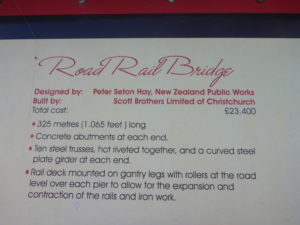

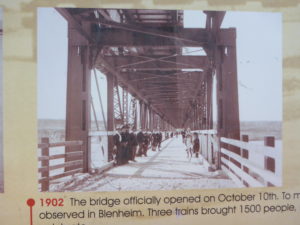
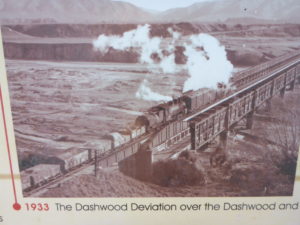

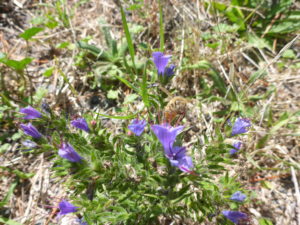
A man of many hats Peter Yealand learned much from his father who was an intelligent and fearless man. Peter’s motto is ‘Think Boldly, Tread Lightly, and never say it can’t be done.’ He has certainly lived by these words and is an inspiration to many. Many of his loyal staff have been with him from the start. We bought his book simply because he is one of those rare and interesting people.
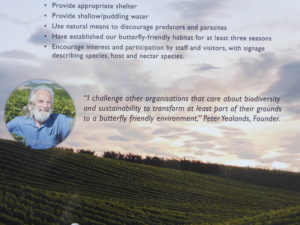
Vicky crunched along the ‘White Road’ around his estate, the white being partly created by the green lipped mussel shells from the farm that was his business before he went into wine. We paused at the side of the road to listen to the classical music that is relayed through speakers to serenade the vines and help them grow and produce healthy fruit and the chickens to lay big eggs. The curious chickens came across to see us, they live around the vines and eat the bugs that harm the grapes. We learned that Babydoll sheep I have mentioned before graze the base of the vines to keep them clean and they hope to increase their flock to 10,000 in the next few years.
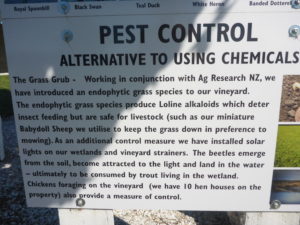
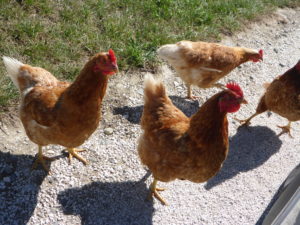
The vines spread over 1000 hectares of sea salt swept headland and Peter’s two fold intention is to produce good wines in a sustainable and energy efficient way in the world’s first carbon Zero Cert TM winery. The building is located at the centre of the vineyard under an elegant sloping roof covered with more solar panels than any other single installation in NZ, over 1800 if I remember correctly.
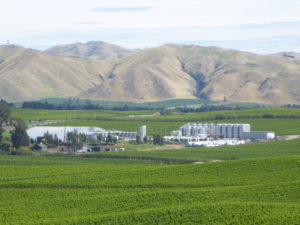

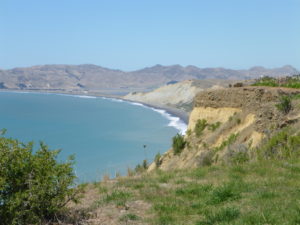
Peter planted most of the vines himself using state of the art GPS equipment he introduced on its trial run in NZ. He also owns five vineyards in the Blenheim area of Marlborough wines but here his plans were to go beyond the local market to the global arena and for this he sensibly assembled a brains trust of experts with advice and guidance on all aspects of his plan so that he could get on with what he loves most, working on the land he cherishes. When we were there he was out on his bulldozer shaping a very steep bank that no one else dared to attempt, ready for a new dam to create another wetland area.

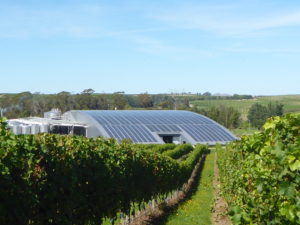
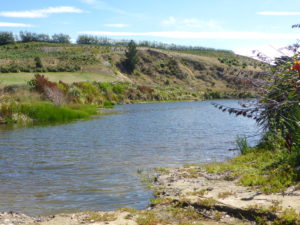
He plants these areas with trees and shrubs to attract a variety of birds and butterflies and visitors can picnic at them on their self-guided tour of the estate. His doors have been open to the public from day one on 08.08.08 and as we walked through them we were in a beautiful lobby clad in wood from his own sustainable forest. The smiling receptionist sat behind a vast kauri desk with up turned ends and as we entered the tasting room smiles from the bar staff welcomed us.
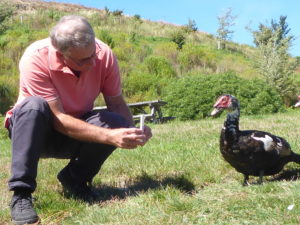

A bit like the Boston ‘Cheers’ bar we all sat around the bar in the centre so numerous parties could enjoy a tasting at the same time and share opinions. We tried six wines and one new fortified experimental wine and liked them all especially the crisp Sauvignon. We bought two bottles but way more important than that we bought the book about this amazing man Peter Yealand titled ‘A Bloke for All Seasons’ the capitals are mine, by Tom Percy and a great read it is proving to be.
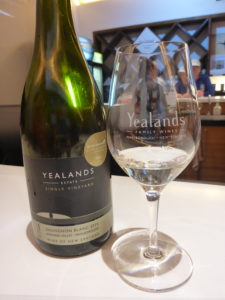
We drove away satisfied in the knowledge that his delicious ‘Sav’ is available in most UK supermarkets.
By the time we had negotiated our way back to Blenheim we were ready for lunch. The narrow road leading to the Brancott Estate was bordered with flowering roses and we could have hired bikes and ridden around the rows of vines with a guide enjoying a tasting amongst the plants and learning how they are another environmentally sensitive team of growers. Then we could have watched a falcon display using the rare New Zealand falcon but we were time strapped and more importantly, hungry.
So we dined by the window overlooking miles and miles of vineyards spreading to the Pacific shores in a very modern glass restaurant set neatly into a small rise in the land. The food was delectable and the tartlet pastry I had just melted in the mouth, how do they do that?
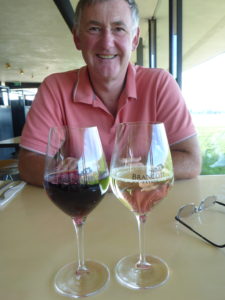
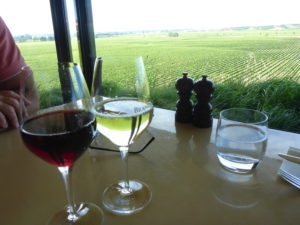


What a wonderful day, filled with genuinely open and nice people, fine weather, interesting history, beautiful places and lovely wine.
